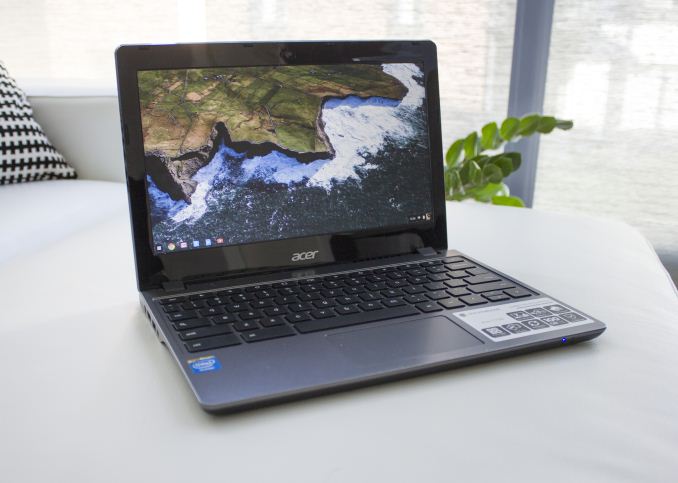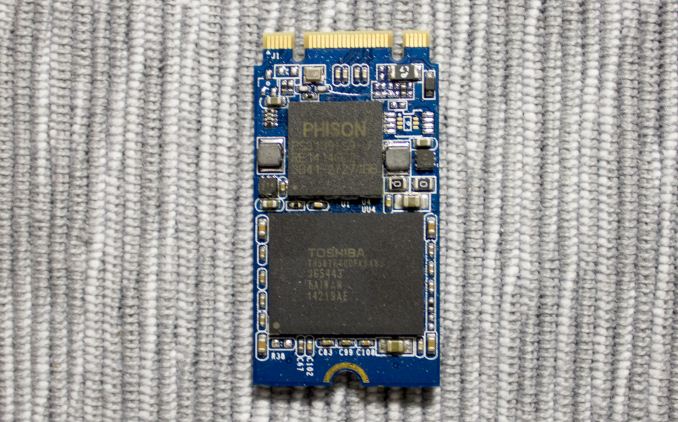Upgrading the SSD in Chromebook & MyDigitalSSD Super Boot Drive M.2 2242 SSD Review
by Kristian Vättö on October 21, 2014 8:00 AM EST
While the whole netbook boom kind of died with the introduction of tablets, Chromebooks have been gaining more and more traction recently. The original Windows netbooks failed to provide a smooth user experience due to the lack of operating system optimization, and Windows was simply way too heavy to be run with such limited resources. Chrome OS on the other hand was designed specifically for netbook-like devices. Google took a totally different approach by designing the Chrome OS around web and cloud-based services, which allowed the OS to be run with very little onboard storage.
Most of today's Chromebooks actually ship with either a small mSATA/M.2 SSD or have an eMMC package onboard, which is a bit ironic since Chromebooks are generally the cheapest laptops around, yet if you buy a Windows laptop that costs twice as much you will most likely end up with a traditional hard drive for storage. That is an enormous benefit that Chromebooks have because the lack of a hard drive enables much thinner and lighter designs, which translates into a better user experience.
The majority of the Chromebooks have 16GB of onboard storage with some high-end models having twice that. For the intended usage where everything is done in the web, that is sufficient, but when you need local storage for offline occasions (e.g. when traveling), 16GB or 32GB will not get you far. There is always the option of carrying external storage to expand the internal storage, but there is another alternative: upgrading the internal SSD.
For the purpose of this review, MyDigitalSSD sent us a 256GB Super Boot Drive in M.2 2242 form factor along with Acer's C720-2848 Chromebook.
| Acer C720-2848 Chromebook Specifications | |||||||||
| Display | 11.6" 1366x768 | ||||||||
| Processor | Intel Celeron 2955U (2/2, 1.4GHz, 2MB, 15W) | ||||||||
| Graphics | Intel HD Graphics (200MHz, 1GHz max Turbo) | ||||||||
| Memory | 2GB DDR3 | ||||||||
| Storage | 16GB SSD (M.2 2242) | ||||||||
| Connectivity | WiFi (802.11 a/b/g/n), Bluetooth 4.0, 1x USB 3.0, 1x USB 2.0, SD card reader, 1x HDMI | ||||||||
| Dimensions | 11.34" x 8.03" x 0.78" (W x D x H) | ||||||||
| Weight | 2.98lb | ||||||||
The C720 is what you would expect a Chromebook to be. The display is a bad TN panel, the trackpad does not always feel responsive, and the overall build is just plastic. It feels cheap, but the positive thing is that it really is cheap, as the C720-2848 currently retails for just $200. I cannot really give an objective review of the laptop itself as I have not used any other Chromebooks, but overall I am fairly impressed with what $200 gets you nowadays.
| MyDigitalSSD Super Boot Drive M.2 2242 Specifications | |||||||||
| Capacity | 8GB | 16GB | 32GB | 64GB | 128GB | 256GB | |||
| Controller | Phison S9 (PS3109) | ||||||||
| NAND | Toshiba A19nm MLC | ||||||||
| Sequential Read | Up to 545MB/s | ||||||||
| Sequential Write | Up to 410MB/s | ||||||||
| Warranty | Three years | ||||||||
Like other MyDigitalSSD's SSDs, the Super Boot Drive is based on a Phison controller and comes in a variety of capacities. The M.2 2242 currently tops out at 256GB since the form factor limits the number of NAND packages to two, and with 16GB die 128GB packages are the biggest that are available in the open market.
Notice that there is no DRAM at all. The M.2 2242 form factor lacks the space for a dedicated DRAM chip, so the NAND mapping table and host IO caching is done in the internal caches of the controller (usually a few megabytes of SRAM). There is a bit of a performance penalty from doing that as the internal caches are much smaller, but it is the only viable way to squeeze a full SSD into such small area.
Test Systems
There are two major items we want to look at in this review: first, we want to investigate the upgrade procedure for the Acer C720 Chromebook and examine Chrome OS performance, and second we're going to look at the MyDigitalSSD Super Boot Drive as a standard SSD and run our usual storage tests. For AnandTech Storage Benches, performance consistency, random and sequential performance, performance vs. transfer size and load power consumption we use the following system:
| CPU | Intel Core i5-2500K running at 3.3GHz (Turbo & EIST enabled) |
| Motherboard | ASRock Z68 Pro3 |
| Chipset | Intel Z68 |
| Chipset Drivers | Intel 9.1.1.1015 + Intel RST 10.2 |
| Memory | G.Skill RipjawsX DDR3-1600 4 x 8GB (9-9-9-24) |
| Video Card | Palit GeForce GTX 770 JetStream 2GB GDDR5 (1150MHz core clock; 3505MHz GDDR5 effective) |
| Video Drivers | NVIDIA GeForce 332.21 WHQL |
| Desktop Resolution | 1920 x 1080 |
| OS | Windows 7 x64 |
Thanks to G.Skill for the RipjawsX 32GB DDR3 DRAM kit
For slumber power testing we used a different system:
| CPU | Intel Core i7-4770K running at 3.3GHz (Turbo & EIST enabled, C-states disabled) |
| Motherboard | ASUS Z87 Deluxe (BIOS 1707) |
| Chipset | Intel Z87 |
| Chipset Drivers | Intel 9.4.0.1026 + Intel RST 12.9 |
| Memory | Corsair Vengeance DDR3-1866 2x8GB (9-10-9-27 2T) |
| Graphics | Intel HD Graphics 4600 |
| Graphics Drivers | 15.33.8.64.3345 |
| Desktop Resolution | 1920 x 1080 |
| OS | Windows 7 x64 |
- Thanks to Intel for the Core i7-4770K CPU
- Thanks to ASUS for the Z87 Deluxe motherboard
- Thanks to Corsair for the Vengeance 16GB DDR3-1866 DRAM kit, RM750 power supply, Hydro H60 CPU cooler and Carbide 330R case












67 Comments
View All Comments
hojnikb - Tuesday, October 21, 2014 - link
Given the space constraints of the 2242, wouldn't make more sense to go with something like sandforce ?This is already designed with dramless in mind, so it would perform better. And at this point, these old controllers must be dirt cheap.
Also one more thing. Given how many cheap laptops use eMMC instead of real ssds, would it be possible to test that aswell ? As i'm aware, eMMC solutions are usually not that fast, but i do wonder how slow they really are.
III-V - Thursday, October 23, 2014 - link
eMMC 5.0 should be very fast, and should be surfacing in devices this year.noelbonner - Tuesday, November 11, 2014 - link
I'd go for one of the top laptops on the market instead (like the rankings at http://tinyurl.com/msegfz9 for example).duploxxx - Tuesday, October 21, 2014 - link
Anandtech quote:While the whole netbook boom kind of died with the introduction of tablets, Chromebooks have been gaining more and more traction recently. The original Windows netbooks failed to provide a smooth user experience due to the lack of operating system optimization, and Windows was simply way too heavy to be run with such limited resources
requires a BIG correction, AMD Brazos was and still is more then fine to run these netbook designs, a 7.2k or better SSD HD gives a very good daily usage of that device. It are the horrible ATOM all over the world thx to Intel and OEM designs that screwed the netbook usecases......
just like first generation ATOM for tablet is useless and made th windows tablet flop.
lilmoe - Tuesday, October 21, 2014 - link
Exactly. Hardware played a larger role in the failure of netbooks. It was simply too slow, and low power processors weren't "there" yet.Microsoft should make a huge comeback with Windows 10 in netbook form factor. Interesting will be the price and capabilities of these devices. Good performing $150-$250 Windows 10 netbooks will eat Chromebooks' lunch and make it seem they never really existed.
titaniumalloy - Tuesday, October 21, 2014 - link
I think the biggest problem is that they had stupid slow 320GB HDD. If they had used 16GB SSD, the machines would have been good. Of course, SSD were pricey 4 years ago. I believe if Microsoft come back into the netbook arena, they would perform well. Microsoft is usually way to ahead of its time or too far behind.hojnikb - Tuesday, October 21, 2014 - link
Dont forget. Very first netbooks were fitted with ssds (very small ones though).andrewaggb - Tuesday, October 21, 2014 - link
I owned 2 netbooks, one with an atom processor and a 1024x600 res screen, one with an amd c50 and 1280x720 screen.I hated them both. The keyboards were small and cramped, the screen resolution on both needed to be 768 minimum height. The hard disks were painfully slow, it took forever to get anything loaded. The amd c50 cpu was awful. It was cpu bound by all sorts of things and not nearly enough applications were gpu accelerated.
Personally, I think the 11-13" laptop range is a much better size, with at least a 1366x768 resolution and an ssd. We have those today, but not for $200.
I'd definitely rather have windows than a chromebook, but microsoft needs to get their windows updates streamlined and smaller...
jabber - Wednesday, October 22, 2014 - link
I've tried some of the new ultra cheap Windows 8.1 laptops with AMD E1 CPUs etc. and they are terrible. The CPU is so underpowered it runs at 100% the whole time. Poor HDD performance etc. Miserable experience. The problem is these are the new cheap laptops folks are buying. Makes you really appreciate a lowly Athlon or Celeron CPU, at least they worked. In comparison a Chromebook works far better for the average Joe.abianand - Thursday, October 23, 2014 - link
Let us hope the laptop manufacturers stop pairing Windows 8.1 only with slow CPUs.Richland and Kaveri have many design wins and have many (I say many, keeping in mind I'm talking about AMD CPUs here) laptops in the US market but not in many other countries.